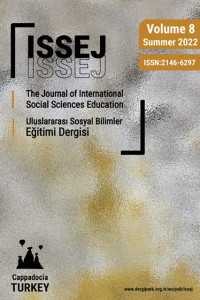Hadisler Çerçevesinde Hz. Peygamber’in Eğitim Metodu.
: Hz. Peygamber, hadis, eğitim, ilkeler
Prophet Mohammed’s Teaching Method in The Framework of Hadiths
Prophet Mohammed hadith, teaching, principles, methods,
___
- Ahmed b. H. (1313). Müsned. el-Matbaatü’l-Meymuniyye.Bilgin, B. (1991). İslam ve çocuk. DİB Yayınları, Ankara.Buhârî, E. A. M. b. İ. (2017). Sahîhu’l-Buhârî, Müssesetü’r-Risâle, Beyrut, Lübnan.Dodurgalı, A. (1999). Din eğitimi-öğretiminde ilkeler ve yöntemler. İFAV Yayınları, İstanbul.Ebû Dâvûd, S. b. E. S. (2015), Sünen-i Ebî Dâvûd, Müssesetü’r-Risâle, Beyrut, Lübnan.Ebû Gudde. (2017). Bir eğitimci olarak Hz. Muhammed ve eğitim metodu. Otto Yayınları, Ankara.Ergenç, K. (2019). Gelenek ve modernlik arasında eğitimde özgünlük. http://www.imhgebze.com adresinden 24.07.2019 erişildi.Fayda, M. (1989). “Âişe” Türkiye Diyanet Vakfı İslam Ansiklopedisi, TDV Yay., İstanbul. Gözütok, Ş. (2017). Hz. Peygamber döneminde eğitim öğretim. Ensar Neşriyat, İstanbul.Gürel, R. (2015). Hz. Peygamber’in (S.A) eğitim-öğretim modelinde belli başlı ilke ve metotlar. Yakın Doğu Üniversitesi İslam Tetkikleri Merkezi Dergisi, 1(2), 120.Hâkim en-Nisaburi, A. M. (t.y). Müstedrek al’s-sahihayn, Mektebetü’l-Matbuati’l-İslami, Haleb.Hökelekli, H. (1995). Hz. Peygamber’in çocuklara ve gençlere yaklaşımı. Hz. Peygamber ve Gençlik, Ankara. İbn Mace, M. b. Y. K. (2013). Sünen-i İbn Mace, Müssesetü’r-Risâle, Beyrut, Lübnan.İslâm ve ihsân. www.İslâm ve ihsân.com/Peygamberimizin -42- Eğitim Metodu adresinden 24.04.2019 erişildi.Karataş, M. (2003). Hz. Peygamber’in beden dili. İstanbul Üniversitesi İlâhiyat Fakültesi Dergisi, 8, 101-138.Müslim, E. H. M. b. H. (2016). Sahîh-i Müslim. Müessesetü’r-Risâle, Beyrut, Lübnan.Nesâî, E. A. A. b. Ş. (2017). Sünenü’n-Nesâî, Müssesetü’r-Risâle, Beyrut, Lübnan.Özek, A. (1991). Bir eğitimci olarak Hz. Muhammed. Esra Yayınları, Konya.Sünbül, A. M. (2007). Öğretim ilke ve yöntemleri. Çizgi Kitabevi, Konya.Taberanî, E. K. S. b. A. (1985). el-mu’cemu’l-kebir. Dâru İhyâi’t-Turâsi’l-Arabî, Beyrut. Taşpınar, M. (2009). Kuramdan uygulamaya öğretim ilke ve yöntemleri. Data Yayınları, Ankara.Tirmizî, E. Î. M. b. Î. b. S. (2017). Sünenü’t-Tirmizî. Müessesetü’r-Risâle, Beyrut, Lübnan.Ünal, İ. H. “Hadiste Yerellik ve Evrensellik”, wordpressportal3, adresinden 24.04.2019 erişildi.
- Başlangıç: 2011
- Yayıncı: Abdulkadir UZUNÖZ
Sınıf Öğretmeni Adaylarının Müzik Eğitimine İlişkin Görüşleri
Mustafa OYMAKCIER, Özlem ÖZALTUNOĞLU
Hz. İsa’nın Ölümü ve Ref’inin Naslar Bağlamında Tetkiki
ALLAH’IN İSİM VE SIFATLARININ SONSUZLUĞU BAĞLAMINDA ŞEFAAT
Hızlı Prototipleme Öğretim Tasarımı Modeli: Bir Ders Senaryosu Örneği
